The Day of the Dog as a fixed date is on the 1st November each year. It is a modern invention of the Japanese pet dog industry which came about as follows. In every language dogs have different barks: in Czech "haf haf", in German "wau wau", in English "woof woof" and in Japanese "wan wan". Because "wan" is phonetically similar to the pronunciation of the English word "one" the first of November was chosen as the Day of the Dog (wan wan wan). This day thus is merely part of a promotional, sales increasing strategy.
Japanese women can also celebrate the dog's day at Suitengu shrines. One of these shrines is located in Tokyo. This shrine originating from the 12th century is especially dedicated to the day of the dog where women pray for fertility and a smooth birth but also against danger caused by water (Suiten is at the same time the goddess of water). At the entrance to the altar there is a statue of a bitch with a puppy. Touching the pup's head bodes well for the expected child and the family. As one can see on the picture the pup's head is quite blank and shining due to the many touches.
Remarkably in the Czech Republic a dog is also portrayed which is believed to bring good luck when touched. This is a relief on the Charles Bridge in Prague, known to everyone who has ever visited that famous bridge. However how this custom developed and what the dog means is not widely known.
According to legend Nepomuk was confessor to Queen Sophie, consort of Wenceslas IV, King of Germany and Emperor of Bohemia. Being a jealous and irascible man the king demanded to know what his wife Sophie had confided to the priest under the pledge of confessional secret. But in spite of atrocious torture Nepomuk kept the confessions to himself so that finally King Wenceslas had the loyal and discreet Nepomuk in 1393 thrown from the bridge and drowned in the rapid Muldaw River.
The two reliefs represent these events. The left relief shows the confessional in the background and in the foreground a man in knight's armour (presumably Wenceslas himself) with a dog. The right relief shows the bridge fall in the background and in the foreground a mother with her child, a biblical allusion to the murder of the children of Bethlehem by Herod. Both motifs, the dog and the child murder, are to typify the king's raw character. The dog was chosen because Wenceslas as a passionate hunter used to surround himself with fierce dogs. According to another legend his hound dogs have been blamed for the death of Queen Johanna, the king's first consort. It is said that in the night of December 31, 1386 in Karlstejn castle she sat up in her bed so suddenly that she startled the dogs in the bedroom to such an extent that they bit her to death.
The legend of St Nepomuk and the custom of touching the reliefs bear more than external resemblance to the ritual and the dog figures in the Suitengu Shrine. Thus St Nepomuk is not only a patron of discreetness and bridges but also protects against water dangers. As we have seen, pregnant women in the Suitengu Shrine also pray for protection against dangers caused by water. One might consider these to be coincidences but it remains indisputable that the dog is a universal symbol of good luck. His positive symbolic expressiveness is so strong that even an originally negative meaning such as recklessness can sink into oblivion and turn into the reverse. Today the dog on the relief at the feet of St Nepomuk is no more than a good luck dog fulfilling wishes.
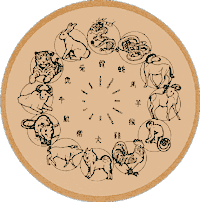 The Day of the Dog as a flexible holiday is quite different. It has a centuries-old tradition and traces back to the Chinese astrological calendar used to determine a person's character and future. This calendar is based on a complex system for counting years, months and hours by means of 5 element symbols and 12 animal symbols. Especially well known are the signs of the zodiac (tiger, monkey, dog etc.). Each one is associated with one year within a 12-year period. Thus for example 1994 was the last Year of the Dog while 2006 will be the next. In the 6th century A.D. this calendar was taken over by the Japanese from China and integrated into the indigenous Shinto religion. In Japan (as well as in China) the astrological calendar (kanshi or eto) is still in use besides the official Gregorian calendar.
The Day of the Dog as a flexible holiday is quite different. It has a centuries-old tradition and traces back to the Chinese astrological calendar used to determine a person's character and future. This calendar is based on a complex system for counting years, months and hours by means of 5 element symbols and 12 animal symbols. Especially well known are the signs of the zodiac (tiger, monkey, dog etc.). Each one is associated with one year within a 12-year period. Thus for example 1994 was the last Year of the Dog while 2006 will be the next. In the 6th century A.D. this calendar was taken over by the Japanese from China and integrated into the indigenous Shinto religion. In Japan (as well as in China) the astrological calendar (kanshi or eto) is still in use besides the official Gregorian calendar.
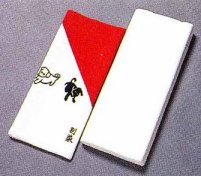 The traditional Day of the Dog (Inu no hi) also has its origins in the Chinese calendar. It is not fixed to a definite date in the year but is celebrated individually by pregnant women. In Japan as well as in China the dog is not only a symbol of loyalty, but is also a symbol for a smooth and painless birth because bitches are believed to give birth to several puppies without complications. For this reason many women in Japan celebrate the dog's day on a Tuesday in the fifth and ninth month of pregnancy by wrapping a long sash with a puppy embroidered on it (iwata-obi) around their stomach. This ritual is intended to evoke a safe birth. The iwata-obi is made of cotton and has the national colours white and red (see picture).
The traditional Day of the Dog (Inu no hi) also has its origins in the Chinese calendar. It is not fixed to a definite date in the year but is celebrated individually by pregnant women. In Japan as well as in China the dog is not only a symbol of loyalty, but is also a symbol for a smooth and painless birth because bitches are believed to give birth to several puppies without complications. For this reason many women in Japan celebrate the dog's day on a Tuesday in the fifth and ninth month of pregnancy by wrapping a long sash with a puppy embroidered on it (iwata-obi) around their stomach. This ritual is intended to evoke a safe birth. The iwata-obi is made of cotton and has the national colours white and red (see picture).
 A prominent example for the celebration of the dog's day has been Crown Princess Masako. In the presence of her husband, the Crown Prince Naruhito, and attended by her ladies of the court she wore a sash (obi) in the Togu Palace in Tokyo in the fifth and the ninth months of her pregnancy in 2001. Unlike the ordinary iwata-obi this sash is worn over the traditional
kimono (see picture). The obi worn by the crown princess was made of silk, 4½ meters long and was a gift from Emperor Akihito. In Japan the media covered the ceremony at the court in detail and it finally found its long-desired happy end: on December 1, 2001, after eight childless years Princess Aiko was born.
A prominent example for the celebration of the dog's day has been Crown Princess Masako. In the presence of her husband, the Crown Prince Naruhito, and attended by her ladies of the court she wore a sash (obi) in the Togu Palace in Tokyo in the fifth and the ninth months of her pregnancy in 2001. Unlike the ordinary iwata-obi this sash is worn over the traditional
kimono (see picture). The obi worn by the crown princess was made of silk, 4½ meters long and was a gift from Emperor Akihito. In Japan the media covered the ceremony at the court in detail and it finally found its long-desired happy end: on December 1, 2001, after eight childless years Princess Aiko was born.

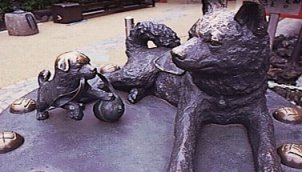
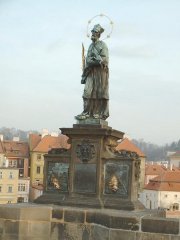 The relief is part of the statue of St John Nepomuk which was erected in the middle of the bridge in 1683 being the first of all 30 statues of saints. It is on the left side of the pedestal, on the right side is another relief. The story behind the erection of the statue is a mixture of legend and historical facts that are much more profane. Here we will keep away from history.
The relief is part of the statue of St John Nepomuk which was erected in the middle of the bridge in 1683 being the first of all 30 statues of saints. It is on the left side of the pedestal, on the right side is another relief. The story behind the erection of the statue is a mixture of legend and historical facts that are much more profane. Here we will keep away from history.
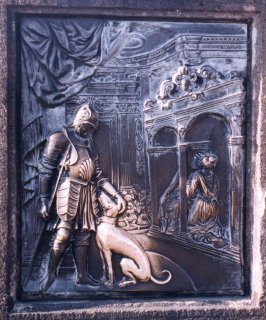
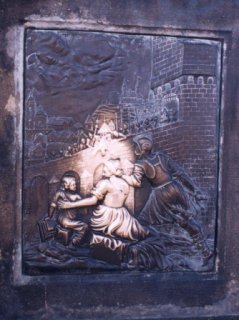
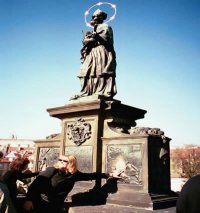 All this background assumedly is unknown to most of the native and foreign visitors to the Charles Bridge. Well known is only the belief that a wish will come true and that one will return to Prague if one touches one of the reliefs with the left hand and wishes for something. It is uncertain if this is an old Czech custom, but it is for sure that Italian tourists who are acquainted with similar customs in their own country have made it popular. The custom is performed so often that both reliefs – like the pup figure in the Suitengu Shrine – are blank and shine gold due to the many touches.
All this background assumedly is unknown to most of the native and foreign visitors to the Charles Bridge. Well known is only the belief that a wish will come true and that one will return to Prague if one touches one of the reliefs with the left hand and wishes for something. It is uncertain if this is an old Czech custom, but it is for sure that Italian tourists who are acquainted with similar customs in their own country have made it popular. The custom is performed so often that both reliefs – like the pup figure in the Suitengu Shrine – are blank and shine gold due to the many touches.